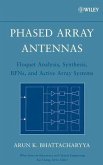A valuable addition to the Wiley Series in Microwave and Optical Engineering Today's modern wireless mobile communications depend on adaptive "smart" antennas to provide maximum range and clarity. With the recent explosive growth of wireless applications, smart antenna technology has achieved widespread commercial and military applications. The only book available on the topic of adaptive antennas using digital technology, this text reflects the latest developments in smart antenna technology and offers timely information on fundamentals, as well as new adaptive techniques developed by the authors. Coupling electromagnetic aspects of antenna design with signal processing techniques designed to promote accurate and efficient information exchange, the text presents various mechanisms for characterizing signal-path loss associated with signal propagation, particularly for mobile wireless communications systems based on such techniques as joint space-frequency adaptive processing. In clear, accessible language, the authors: * explain the difference between adaptive antennas and adaptive signal processing * Illustrate the procedures for adaptive processing using directive elements in a conformal array * clarify multistage analysis procedure which combines electromagnetic analysis with signal processing * present a survey of the various models for characterizing radio wave propagation in urban and rural environments * describe a method wherein it is possible to identify and eliminate multipath without spatial diversity * optimize the location of base stations in a complex environment The text is an excellent resource for researchers and engineers working in electromagnetics and signal processing who deal with performance improvement of adaptive techniques, as well as those who are concerned with the characterization of propagation channels and applications of airborne phased arrays.
Dieser Download kann aus rechtlichen Gründen nur mit Rechnungsadresse in A, B, BG, CY, CZ, D, DK, EW, E, FIN, F, GR, HR, H, IRL, I, LT, L, LR, M, NL, PL, P, R, S, SLO, SK ausgeliefert werden.









